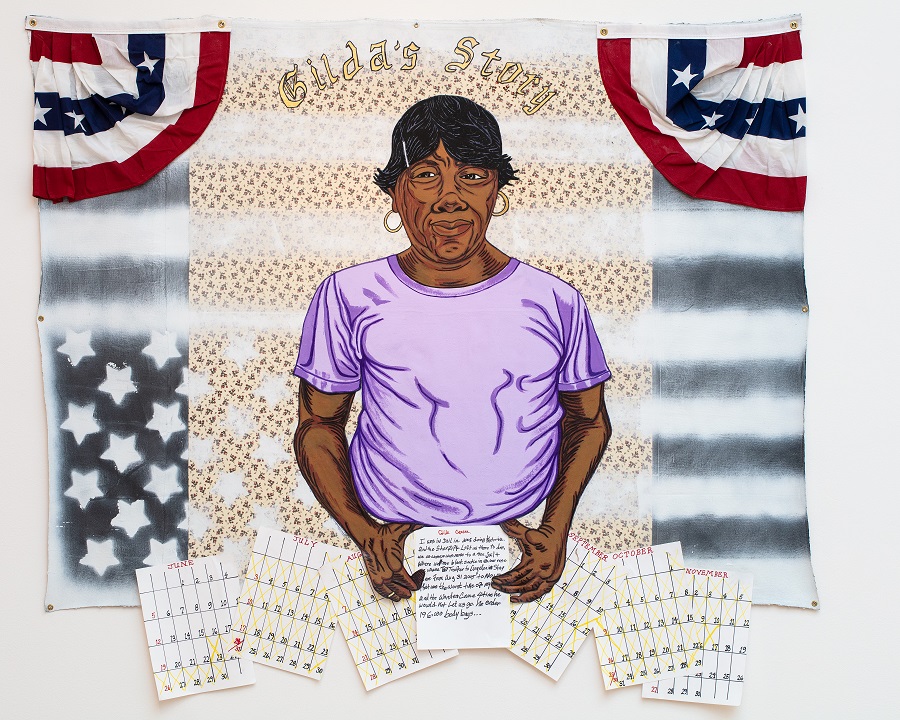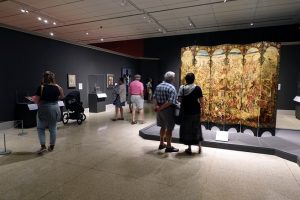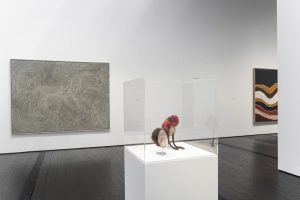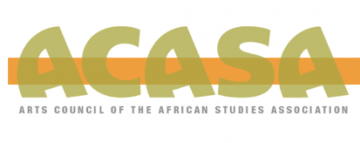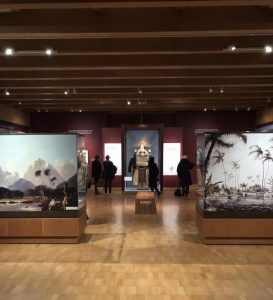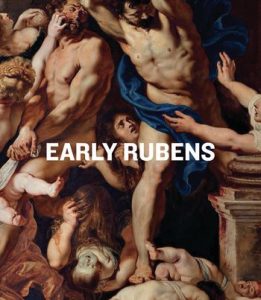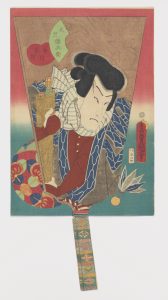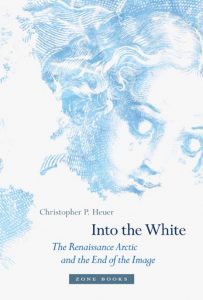CAA News Today
News from the Art and Academic Worlds
posted by CAA — December 25, 2019
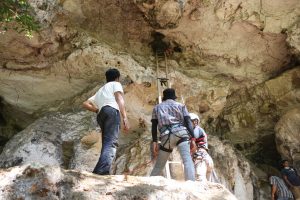
The overhead entrance to the previously uncharted chamber in Indonesia, which houses cave art that dates back at least 43,900 years. Credit: Ratno Sardi for The New York Times
Mythical Beings May Be Earliest Imaginative Cave Art by HumansThe paintings found in central Indonesia—which are at least 43,900 years old—may shift an understanding of when and where humans started depicting imaginary figures. (New York Times)
Want articles like these in your inbox? Sign up: |
Juan Carlos Rodriguez Rivera and Allison Yasukawa
posted by CAA — December 23, 2019
The weekly CAA Conversations Podcast continues the vibrant discussions initiated at our Annual Conference. Listen in each week as educators explore arts and pedagogy, tackling everything from the day-to-day grind to the big, universal questions of the field.
CAA podcasts are on iTunes. Click here to subscribe.
This week, Juan Carlos Rodriguez Rivera and Allison Yasukawa discuss international and multilingual students at art/design schools.
Juan Carlos Rodríguez Rivera is a queer boricua visual communicator and educator, passionate about food, lover of gradients, and anything with glitter. Juan was born and raised in Cataño, the smallest town of Puerto Rico, but relocated to San Francisco, California in 2017. Juan’s work focuses on challenging colonial perspectives in design from the point of view of a boricua diaspora. Juan Carlos is an Assistant Professor in the Design Department at California College of the Arts, and holds an MFA in Communications Design from Pratt Institute in NY.
Allison Yasukawa is a visual artist and educator. She holds an MFA in Studio Arts and an MA in TESOL and Applied Linguistics. In her studio practice, she explores asymmetries of power and imagined geographies in interactional spaces ranging from the personal to the global. Yasukawa’s pedagogy focuses on studio and academic classes in English for Art and Design. She is the Director of English Language Learning at the California Institute of the Arts and has presented nationally and internationally on art-language overlaps in critique instruction, student autonomy, and multilingualism as a creative resource.
New in caa.reviews
posted by CAA — December 20, 2019
Jillian Hernandez discusses the show Per(sister): Incarcerated Women of Louisiana, from the Newcomb Art Museum, Tulane University. Read the full review at caa.reviews.
Lauren G. Kilroy-Ewbank reviews the exhibition Art and Empire: The Golden Age of Spain at San Diego Museum of Art. Read the full review at caa.reviews.
Adrienne Rooney covers the Menil Collection’s Mapa Wiya (Your Map’s Not Needed): Australian Aboriginal Art from the Fondation Opale. Read the full review at caa.reviews.
News from the Art and Academic Worlds
posted by CAA — December 18, 2019
|
|
|
|
Want articles like these in your inbox? Sign up:
International Review: The Many Faces of Human Impacts in The Seventh Continent, 16th Istanbul Biennial
posted by CAA — December 17, 2019
THE MANY FACES OF HUMAN IMPACTS: Exhibition Review of The Seventh Continent, 16th Istanbul Biennial, curated by Nicolas Bourriaud, September 14–November 10, 2019.
The following article was written in response to a call for submissions by CAA’s International Committee. It is by Madeleine Kelly, an artist based in Sydney, Australia.
When artists work with archaeology and anthropology it is easy to imagine their work as a labor entrenched in the past. Yet, in the 2019 Istanbul Biennial—an enormous exhibition in three venues that presented the work of fifty-six artists and art collectives from twenty-six countries—artists engaged with the descriptive capacity of archaeological methods by reinvesting them in the metaphorical dimension of imaginative artifacts and languages. New and complex ways of signifying humanity’s traces, marks, and interactions with the non-human universe emerged, blurring the traditional separation between nature and culture. Following from this, the division between subjects and objects also breaks down, granting subjective agency to stones, plants, and other non-human voices. The most powerful works invented an “inter-subjective relation” (see discussion below) that proceeded by way of the form of the face. As othered subjects are often faceless, the mediums in which they are embodied configure them as anthropological concepts. Entitled The Seventh Continent after the drifting mass of plastic waste that contaminates the world’s oceans, this year’s Istanbul Biennial explored the complex entanglements of anthropogenic climate change and the human impact on the planet.
French curator and art historian Nicolas Bourriaud is known for his controversial book, Relational Aesthetics (1998, English translation 2002), which revitalized the discussion on aesthetics at the time. In it, film critic Serge Daney suggested that the invention of “inter-subjective relation” proceeds by way of the form of the face, an exchange that denotes the consideration we have towards others. Further, to produce a form is to partake in a transitive ethic in which an image mediates the longing to be looked at. He states that “all form is a face looking at me.” In the biennial, Bourriaud drew attention to “the primacy of encounter over form,” arguing that dynamic encounters between different types of beings–and by extension forms–constitute relational formations. I propose that an echo of his early citation of inter-subjective relation is present in forms with subject-like qualities–in particular faces– and that these especially address our relation to dwindling diversity and mounting waste generated by industrial capitalism.

Figure 1: HaZaVuZu art collective, Worlbmon, 2019, installation view and details; Mimar Sinan Fine Arts University Istanbul Museum of Painting and Sculpture (photograph provided by the author)
In the Mimar Sinan Fine Arts University Istanbul Museum of Painting and Sculpture, located in the heart of the city, the Istanbul-based HaZaVuZu art collective presented an alluring grotto-like installation of animated surfaces and faces inspired by everyday packaging, inkblots, and grotesque figures that “look back at us” (Fig. 1). The myriad images recall the semiotic wonderland of Istanbul’s Hagia Sophia Museum, weaving its historical thread of the iconophilic and iconoclastic, but the HaZaVuZu seems to riff on this legacy with forms that oscillate between iconic, indexical, and symbolic sign systems. Bourriaud’s statement (in an introduction to the exhibition) that “the work of art is a signal, akin to those all living organisms emit” seems to crystalize in these works where the artists breathe life into inanimate materials composed of matter seemingly evolving into being.

Figure. 2: Hale Tenger, Appearance (detail), 2019, mixed-media and sound installation, black obsidian mirrors, iron, epoxy resin based paint, water, audio-spotlight speaker, Büyükada Island (photograph provided by the author)
Along with the trope of the living work is that of art as a mirror to the world, reflecting the ineffable operations of nature. Yet in the context of the exhibition, an ideal nature is displaced to expose, as Bourriaud states, “the reverse mirror-image of our societies, the seventh continent is the country we don’t want to inhabit, made up of everything we reject.” On the island venue of Büyükada, a ferry ride from town, Istanbul-based artist Hale Tenger presented a mixed-media and sound installation entitled Appearance (Fig. 2). The viewer entered an apple orchard on the grounds of the dilapidated Sophronius Palace in which round black obsidian mirrors and pools of water reminiscent of black oil reflected skyscapes and trees. A voice from the house hoarsely whispered a poem by the artist: “I was a fruit tree . . . I gave, without expecting reciprocity . . . can you be by not doing?” And when we saw our faces reflected in the black mirrors we felt caught up in the quotidian complicities conjured by the question.
Another compelling work, this time the face of the deep, was also on the island. Armin Linke’s investigative film Prospecting Ocean (2018) transported viewers to the world of deep-sea politics where activists organize protests against seabed mining and the technocratic entanglement of industry, science, politics, and the economy. In the accompanying installation of documents related to Italian and Turkish marine history, a book chapter entitled “Ion by Ion,” by marine scientists Bruce Heezen and Charles Hollister, beautifully describes the evolution of mineral gardens comprised of manganese nodules. These polymetallic rock concretions accumulate daily in atomic layers and correlate with species abundance. Like strata that accumulate in the layers of a painting, the nodules embody an enlivening vitality.

Figure 3. Mika Rottenberg, still from Spaghetti Blockchain, 2019, 4K color video installation with 7.1 surround sound, 18:15 min.; Mimar Sinan Fine Arts University Istanbul Museum of Painting and Sculpture (artwork © Mika Rottenberg; photograph provided by the artist and Hauser & Wirth)
Artist Mika Rottenberg’s rapid-edit video Spaghetti Blockchain presents more strata, but hers are of oozy plastic modelling compounds, cakes that accumulate in layers of artificially coloured jelly, and molecular models scaffolded from skewers and marshmallows (Fig. 3). The film cuts to a potato-processing plant that rips through tree branches and thousands of potatoes in granular form. The agency of the hand appears as a critical element, often framed by hexagonal kaleidoscopic apertures that “blink” us through the brilliantly edited comic nightmare of her “organic chemistry.” Bourriaud proposes, “today’s artists practice a type of anthropology that one could call molecular.”

Figure 4: Eloise Hawser, Feathering, 2019, video sculpture, 76 x 101 x 20 in. (193.6 × 257 × 50 cm), steel, laminated and repurposed glass panels, Pera Museum (photograph provided by the author)
Another work, The Tipping Hall by London-based artist Eloise Hawser, takes the “petal claw” as its subject. These mechanical fists, with their twenty-six foot (eight meter) talons, do a vital job of aerating the waste of tipping halls to prevent the build-up of toxic gases. This work was displayed in the biennial’s third venue, the Pera Museum, as was Hawser’s Feathering (2019), a mesmeric kinetic sculpture made from waste and showing, at high magnification, the intricate and fine-toothed handling of e-waste (Fig. 4).

Figure 5: Jonathas de Andrade, still from O Peixe (The fish), 2016, 16mm transferred to 2K video, 5.1 sound, screen ratio 16:9 (1.77), 23 min.; Mimar Sinan Fine Arts University Istanbul Museum of Painting and Sculpture (photograph provided by Pedro Urano)
In Brazilian-based artist Jonathas de Andrade’s film O Peixe (The fish) (Fig. 5), Amazonian fishermen ceremoniously embrace and caress their slowly suffocating catch. While stylistically a pastiche of early ethnographic films, the intimate gesture between man and dying fish is an invention of the artist. Pertinent here is the aesthetic encounter between humans and animals being slaughtered, generating uneasy discussions and making this a challenging work.
In many ways, The Seventh Continent was an aestheticizing of the anthropogenic environmental tragedy. These artists translated notions of subjectivity into forms that document and/or question human impact–their forms look back at us, urging us to explore the complex entanglements of anthropogenic climate change and holding us to account for our impact on the planet.
CAA Endorses ACASA’s Statement Concerning Destruction of Cultural Patrimony in Bafut
posted by CAA — December 16, 2019
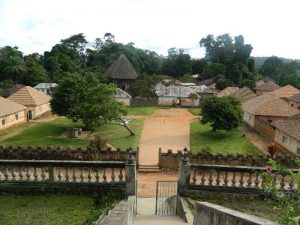
On September 24, soldiers from the Rapid Intervention Battalion (BIR) attacked and looted the Royal Palace, in Bafut, North-West region. © Creative Commons/ShareAlike 3.0, via Human Rights Watch
CAA endorses its affiliate society, the Arts Council of the African Studies Association (ACASA), in condemning recent reports of theft, property damage, as well as violence at the Palace of Bafut in Cameroon.
The site is an important part of the history and culture of the Bafut population in the northwest region of Cameroon, and continues to function as a center for religious rites and ceremonies. The violence and destruction to the Bafut Palace threatens the safety and identity of the Bafut people and the maintenance of their distinctive cultural traditions. As such it deserves protection from the Republic of Cameroon and pressure from organizations and governments to restore damaged structures and return stolen artifacts.
Read ACASA’s statement below.
Statement Concerning Destruction of Cultural Patrimony in Bafut
20 November 2019
The Arts Council of the African Studies Association (ACASA)—an independent professional association which exists to facilitate communication among scholars, teachers, students, artists, museum specialists, collectors, and all others interested in the arts of Africa and the African Diaspora—condemns the violent aggression perpetrated by the Republic of Cameroon against the Palace of Bafut, a site included on UNESCO’s Tentative List of World Heritage Sites since 2006. Human Rights Watch reports that “On September 24 [2019], soldiers from the Rapid Intervention Battalion (BIR) attacked and looted the Royal Palace in Bafut, North-West region.” (https://www.hrw.org/news/2019/10/11/world-heritage-site-attacked-cameroon#) Fon Abumbi II of Bafut protested the aggression in a letter dated September 24, 2019 and addressed to the Governor of North West Region. In addition to causing damage to buildings within the palace and perpetrating violence against those who had been neither charged nor tried in a court of law, these troops representing the authority of the State shamelessly stole historical objects from the palace museum.
According to the World Monuments Fund, the palace “embodies Bafut cultural identity and remains a center for religious rites and traditional ceremonies. Over 50 houses are clustered around the site’s spiritual core, Achum Shrine, and are used by the Fon (king), his wives, and the royal court.” (https://www.wmf.org/project/bafut-palace) The palaces and museums of the North West Region of Cameroon serve as invaluable repositories of the long-standing traditions and material cultures of these vibrant kingdoms. These palaces and associated sites—where ritual practices have long been performed—foster and house the heritages, both tangible and intangible of these communities. The violent destruction and looting of such a site may be understood as an attempt to erase the cultural identity of the Bafut population. As a site listed on the Tentative List of World Heritage Sites, Bafut Palace is recognized as holding even greater than just local significance, constituting a primary locus of cultural heritage for the entirety of Cameroon, and indeed the world. The Cameroonian State must treat these places as the internationally significant cultural heritage sites that they are.
ACASA calls on the Republic of Cameroon to protect sites of cultural heritage as required by being party to the 1954 Hague Convention for the Protection of Cultural Property. According to Article 4(3) of the aforementioned convention, it is the obligation of the State “to prohibit, prevent and, if necessary, put a story to any form of theft, pillage or misappropriation of, and any acts of vandalism directed against, cultural property….” In light of this international obligation, the Cameroonian State must bring to justice and punish appropriately those responsible for this heinous act. Furthermore, every effort must be taken to return looted items of cultural heritage to the palace museum of Bafut.
CC:
Paul Biya, President of the Republic of Cameroon
Henri Etoundi Essomba, Ambassador of the Republic of Cameroon to the US
Peter Henry Barlein, US Ambassador to the Republic of Cameroon
Narcisse Mouelle Kombi, Minister of Arts and Culture for the Republic of Cameroon
UNESCO
World Monuments Fund
Andrew Demirjian and Claudia Hart
posted by CAA — December 16, 2019
The weekly CAA Conversations Podcast continues the vibrant discussions initiated at our Annual Conference. Listen in each week as educators explore arts and pedagogy, tackling everything from the day-to-day grind to the big, universal questions of the field.
CAA podcasts are on iTunes. Click here to subscribe.
This week, Andrew Demirjian and Claudia Hart discuss emerging media, micro to macro.
Drawing from conceptual art, experimental music and computer science, Andrew Demirjian scrapes and remixes Internet culture to create dense rhythmic collages of sound and language. He teaches theory and production courses in emerging media in the Film and Media Department and the Integrated Media Arts MFA program at Hunter College, he is currently a Fellow at the MIT Open Documentary Lab.
Claudia Hart has been active as an artist, curator and critic since 1988. Her art consists of virtual simulations of all kinds: 3d imagery integrated into photography, multi-channel animation installations, performances, and sculptures using advanced production techniques such as Rapid Prototyping, CNC routing and augmented-reality custom apps. Her works deals with issues of representation, the role of the computer in shifting contemporary values about identity and the real, and ideas about what is usually called the “natural.” Her project is to feminize the masculinist culture of technology by interjecting emotional subjectivity into the overly-determined Cartesian world of digital design.
New in caa.reviews
posted by CAA — December 13, 2019
Liza Oliver reviews the British Museum exhibition Reimagining Captain Cook: Pacific Perspectives. Read the full review at caa.reviews.
Catherine H. Lusheck considers the show Early Rubens, currently on view at the Art Gallery of Ontario, Toronto. Read the full review at caa.reviews.
Rebecca L. Twist writes about Dramatic Impressions: Japanese Actor Prints at the Portland Art Museum, Oregon. Read the full review at caa.reviews.
Amy Knight Powell discusses Into the White: The Renaissance Arctic and the End of the Image by Christopher P. Heuer. Read the full review at caa.reviews.
Announcing Pay-as-You-Wish Day for CAA 2020
posted by CAA — December 13, 2019
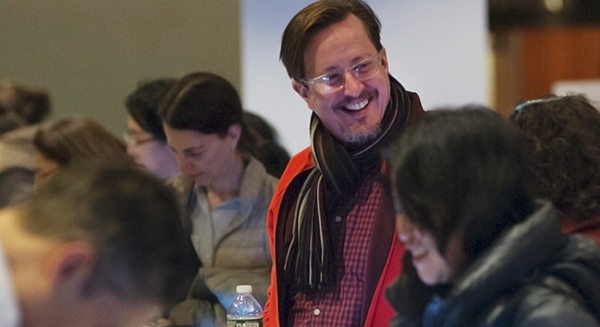
Attendees at the 2019 Annual Conference in New York. Photo: Ben Fractenberg
We’re looking forward to seeing everyone in Chicago, February 12-15, 2020 for the Annual Conference.

We are excited to announce that we will offer Pay-as-You-Wish for one day, Friday, February 14, thanks to generous support from the Carl & Marilynn Thoma Art Foundation.
On Wednesday, Thursday, and Saturday, we will offer a variety of onsite registration options including:
- Single-session timeslot ticket— $20
- Book & Trade Fair only pass— $20
- One Day Pass (includes sessions and Book & Trade Fair)— $100
- Full conference registration— prices vary depending on membership tier
In addition, we have extended Early Registration until 11:59 PM (EST), Wednesday, December 18! Take advantage of early registration, the lowest rates for the full conference, and don’t forget to grab a ticket for our Opening Reception, hosted by Columbia College Chicago.
Notice of CAA 108th Annual Business Meeting
posted by CAA — December 11, 2019
College Art Association
Notice of 108th Annual Business Meeting
Hilton Chicago, 720 S. Michigan Ave., Chicago, Illinois 60605
Wednesday, February 12 and Friday, February 14, 2020
The 108th Annual Business Meeting of the members of the College Art Association will be called to order at 6:00 p.m. CDT on Wednesday, February 12th, during Convocation at the 2020 Annual Conference, in the Grand Ballroom (2nd Floor) of the Hilton Chicago.
CAA President, Jim Hopfensperger, will preside. As is CAA’s custom, the Annual Business Meeting will be held in two parts:
AGENDA
The Agenda for the first part of the Annual Business Meeting is as follows:
I. Welcome – Jim Hopfensperger, CAA President
II. Interim Executive Directors Report – David Raizman – Presentation of CAA Awards for Distinction
III. 2019 Professional Development Fellowships in Visual Arts and Art History — Anne Collins Goodyear, Suzanne Blier, DeWitt Godfrey
IV. Keynote Address – Amanda Williams
After the Keynote Address, the Annual Business Meeting will be recessed and will re-convene on Friday, February 14, from 2:00 – 3:30 p.m. CDT on the 4th floor, Room 4A of the Hilton Chicago. The Agenda for Part II of the Annual Business Meeting is as follows:
V. Approval of Minutes of 107th Annual Business Meeting, February 23, and 25, 2019
See: https://www.collegeart.org/news/2019/12/12/caa-107th-annual-business-meeting-minutes/
VI. Financial Report: Roberto Tofolo, CAA Chief Financial Officer
VII. Old Business
VIII. New Business
- Results of Election of New Directors — Jim Hopfensperger, CAA President
IX. Open discussion with members, Board and staff
Proxies
If you are unable to attend the Annual Business Meeting, kindly complete a proxy online to appoint the individuals named thereon to (i) vote, as directed by you, for directors, and, at their discretion, on such other matters as may properly come before the Annual Business Meeting; and (ii) to vote in any and all adjournments thereof. CAA Members will be notified when the proxy for casting votes becomes available — online in late December 2019. A proxy, with your vote for directors, must be received no later than 6:00 p.m. CDT, Thursday, February 13, 2020.
Next Meeting – 2021
The 109th Annual Business Meeting of the College Art Association will be held in New York in 2021, and again will be divided into two parts – Part I at Convocation on Wednesday, February 17, and Part II a meeting and open discussion on Friday, February 19, 2021.
December 6, 2019



